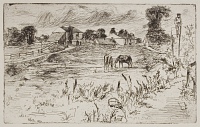Etchings Institutions search term: grolier club
Landscape with Horses | ||
| Number: | 45 | |
| Date: | 1859 | |
| Medium: | etching and drypoint | |
| Size: | 128 x 205 mm | |
| Signed: | 'Whistler.' at lower left | |
| Inscribed: | '1859.' at lower left | |
| Set/Publication: | no | |
| No. of States: | 2 | |
| Known impressions: | 32 | |
| Catalogues: | K.36; M.35; T.23; W.46 | |
| Impressions taken from this plate (32) | ||
KEYWORD
TITLE
'Paysages à cheval' (1872, British Museum). 1
'Paysage au Cheval' (1874, Ralph Thomas, Jr (1840-1876)). 2
'The Landscape with the Horse' (1886, Frederick Wedmore (1844-1921)). 3
'The Meadow' (1909, Howard Mansfield (1849-1938)). 4
'Landscape with the Horse' (1910, Edward Guthrie Kennedy (1849-1932)). 5
'Landscape with Horses' (2010, Whistler Etching Project).
Several of the impressions of the first state are annotated with the title 'Paysage au cheval', possibly basing this on Thomas's title. However, there are actually two horses in the final state, not to mention a workman up the pole. 'Landscape with Horses' is therefore the preferred title.
1: B.M. Print Room Register.
2: Thomas 1874 (cat. no. 23).
3: Wedmore 1886 A (cat. no. 46).
4: Mansfield 1909 (cat. no. 35).
5: Kennedy 1910 (cat. no. 36).
DESCRIPTION
SITTER
 ). Both men appear to be wearing uniforms, with peaked caps with a rounded crown.
). Both men appear to be wearing uniforms, with peaked caps with a rounded crown.6: 'Family and Friends', Whistler, Fitzwilliam Museum website, at http:// www.fitzmuseum.cam.ac.uk (accessed 2009).
SITE
7: Lochnan 1984 , p. 76.
8: K. G. Beauchamp, A History of Telegraphy: Its Technology and Applications, 2000, 3.4.3.
DISCUSSION
9: Lochnan 1984 , pp. 75-76.
10: Ibid.
11: Jules Verne, Revue des Beaux-Arts, vol. 8, 15e livraison (1 August 1857), pp. 285-292, in Volker Dehs (ed.), Jules Verne. Salon de 1857 on-line at http:// www.jules-verne.eu / Salon_1857 (accessed 2009).
12: Philosophie du Salon de 1857, on http://www.archive.org (accessed 2009).
